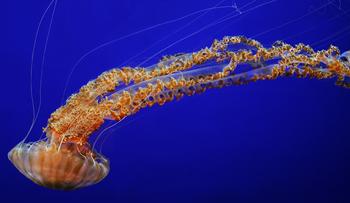
The black sea nettle is considered a giant jelly; its distinctive purplish bell can reach over three feet (91 cm) in diameter; its lacy, pinkish oral-arms can reach nearly 20 feet (6 m) in length and its stinging tentacles 25 feet (7.6 m) or more. It probably lives in deeper, calmer waters but has appeared in large blooms in California coastal waters, most recently in 2010.
(Monterey Bay Aquarium/Randy Wilder)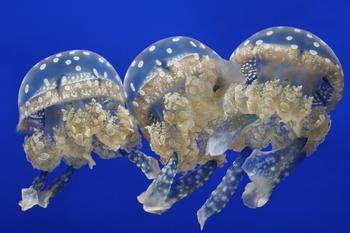
This species is also known as a "lagoon jelly" because it lives in bays, harbors and lagoons in the South Pacific. Spotted jellies have rounded bells and strange clumps of oral arms with clublike appendages that hang down below. Instead of a single mouth, they have many small mouth openings on their oral-arms, which capture small animal plankton. In addition, each jelly grows a crop of algae, which gives them a greenish-brown color. They harvest some of their food directly from the algae.
(Monterey Bay Aquarium/Randy Wilder)
This striking and rare jelly has brilliant, multicolored tentacles trailing from a translucent, pinstriped bell. It also has tentacles around the rim of its bell that it can quickly coil and uncoil. This mysterious jelly is semi-benthic, sometimes spending its time on the seafloor.
(Monterey Bay Aquarium/Randy Wilder)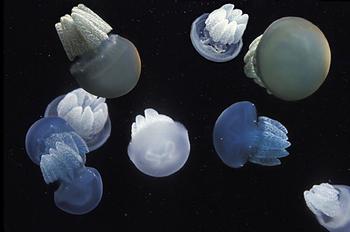
The blue jelly comes in colors ranging from very light blue to dark purple and burgundy, and its bell pulses in a distinctive, staccatolike rhythm. Multiple oral arms and mouths transport food to the jelly's stomach. As with all true jellies, blue jellies alternate between a sexual medusa stage and an asexual polyp stage. Adult medusae brood their fertilized eggs and the resulting planula larvae. People can safely eat this poisonous jelly once it's been correctly dried and processed.
(Monterey Bay Aquarium/Randy Wilder)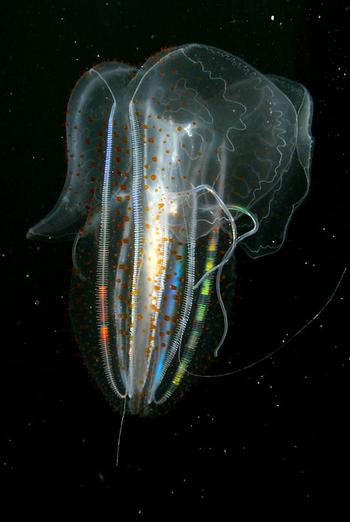
The rare and extremely delicate spotted comb jelly (Leucothea pulchra). This stunning species, found in the Pacific Ocean from California’s Central Coast south to the Sea of Cortez, is very difficult to collect – one touch and the jelly can disintegrate like tissue in water. It can reach nine and three-quarters inches long. It has amazing physiology – it swims horizontally, and its large oral lobes—which can be as long as its body—open to catch prey. It can also fold each lobe into a tube when it finds something to eat.
(Monterey Bay Aquarium)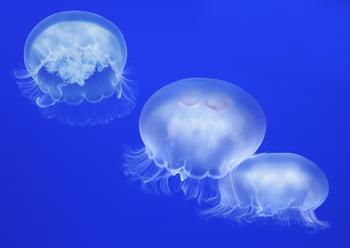
The Moon Jelly (Aurelia spp.) is named after its moon-like bell, which can grow up to 15 inches in diameter and is usually a translucent milky white, although it may be tinted pink or lavender. Instead of long, trailing tentacles, these jellies have a short, fine fringe that helps funnel food—often trapped by mucus on the bell—into the mouth and the four, clearly visible stomach pouches. Moon jellies are common in Monterey Bay and along the California coast, and in waters off the East Coast, Europe, Japan and in the Gulf of Mexico.
(Monterey Bay Aquarium)
